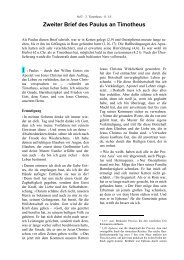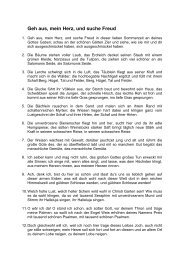Create successful ePaper yourself
Turn your PDF publications into a flip-book with our unique Google optimized e-Paper software.
The kidneys<br />
– marvels of filtration<br />
The human kidney, weighing between 120 and<br />
160 g, is a complex physico-chemical factory<br />
which is essential for purifying the blood (Diagram<br />
p 68). The two kidneys are located on either<br />
side of the backbone in the region of the loins.<br />
They control the fluid balance of the body and<br />
keep constant the composition and volume of the<br />
extra-cellular liquid in which all the cells of the<br />
body are bathed. In this way the functioning of all<br />
the cells of the body is optimised. When there is<br />
too much liquid or too much of dissolved substances,<br />
the kidneys ensure that excesses are eliminated.<br />
If there is a shortage of water, the kidneys<br />
reduce the excretion of water without affecting<br />
the essential elimination of metabolic end-products.<br />
All these processes are carried out in such<br />
a way that the kidneys control the water and salt<br />
content of the blood and excrete the waste products<br />
of protein metabolism (urea) and purine<br />
metabolism (uric acid), as well as any toxins.<br />
For this purpose, blood flows through the kidneys<br />
at an astounding rate – 1.2 litres of blood each<br />
minute, which is four times their own weight. The<br />
specific perfusion of an organ is a term indicating<br />
the amount of blood flowing through it per<br />
minute in proportion to its weight. This amounts<br />
to (1,200 cm 3 blood/min)/(280 g kidney weight) =<br />
4.3 cm 3 /(g x min). This is appreciably higher than<br />
for the other major <strong>organs</strong> like the brain, liver, or<br />
heart muscle. Every day 1,700 litres of blood flow<br />
through the kidneys. This is more than twenty<br />
times the entire body weight and 340 times the<br />
total amount of blood in the body, which is about<br />
5 litres. The quantity of blood passing through<br />
the kidneys in one hour is 15 times the entire volume<br />
of the blood in the circulatory system.<br />
There are about 2.5 million renal glomeruli (Latin<br />
singular glomerulus = the diminutive of glomus<br />
= cluster; plural: glomeruli) which, together with<br />
a similar quantity of renal tubules (having a total<br />
length of nearly 100 km), contribute to a cleverly<br />
designed physical filtering process, actually<br />
a molecular sieve.<br />
The volume of liquid filtered by the glomeruli per<br />
unit of time provides a measure of the excretory<br />
capacity of the kidneys. This is called the glomerular<br />
filtration rate (GFR) which is about 120 cm 3<br />
per minute. This means that approximately 180<br />
litres, which is 60 times as much as the volume of<br />
all the blood plasma (the liquid part of the blood,<br />
being about three litres), are filtered and purified<br />
every day. The total volume of extra-cellular fluid<br />
in the body (including blood) is about 14 litres, so<br />
even this amount passes 13 times per day<br />
through the kidney filter. The renal glomeruli thus<br />
excrete 180 litres of ultra-filtrate (primary urine)<br />
per day. This high volume is required to properly<br />
excrete metabolic products through the capillary<br />
walls. But if this enormous quantity of urine were<br />
passed directly, the water loss would be horrendous.<br />
This volume of urine would fill 18 buckets<br />
a day, and we would never be able to leave the<br />
toilet. What’s more, we would have to drink a<br />
similar quantity of water each day.<br />
However, the all-wise Creator set up an ingenious<br />
principle whereby more than 99 per cent of<br />
the water and the major portion of other vital<br />
substances are returned to the body. As the filtrate<br />
travels further along the renal tubules (diagram<br />
page 69), water, glucose, and sodium chloride<br />
are recovered and returned to the blood. The<br />
recovery ratio is about 100:1, so that only<br />
between 1 and 1.6 litres of urine are eliminated,<br />
depending on the quantity of ingested liquid and<br />
on other water losses (e. g. sweat).<br />
In cross-section (diagram p 69), the kidney displays<br />
an outer granular cortex and an inner, radially<br />
striped medullary layer. The nephron (Greek<br />
nephron = kidney) is the smallest functional<br />
renal unit. It comprises the glomerulus, together<br />
with the blood-transporting arterioles, the renal<br />
tubule, and the papillary duct (left part of the<br />
diagram on page 68). Granular in appearance, the<br />
renal glomeruli are an extremely well-designed<br />
apparatus. The vas afferens 1 (diameter between<br />
20 and 50 µm), conveying the incoming blood,<br />
branches into a bundle of very fine capillaries<br />
67
















